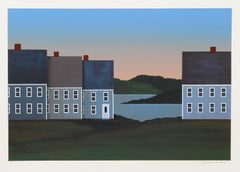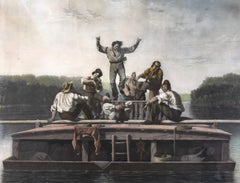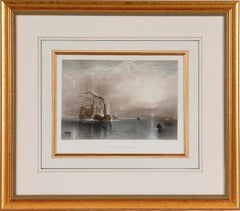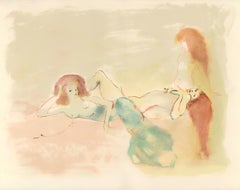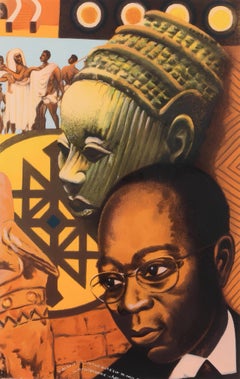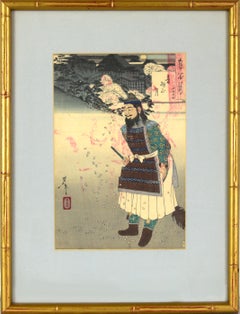Small Landscape Prints
to
1,057
7,981
3,202
2,859
1,608
1,198
Overall Width
to
Overall Height
to
760
610
191
148
135
118
89
80
60
14
8
8
2
2
72
61
61
34
30
274
478
1,711
737
30
14
100
66
76
163
327
347
183
113
139
1,914
1,148
134
1,272
590
452
382
372
304
255
252
217
190
174
151
132
132
131
131
115
106
102
88
1,219
851
527
272
235
396
875
1,937
1,044
Size: Small
Roofs, Folk Art Screenprint by Ted Jeremenko
Located in Long Island City, NY
Ted Jeremenko, Yugoslavian/American (1938 - ) - Roofs. Year: 1987, Medium: Screenprint, Signed and numbered in pencil, Edition: 100, Image Size: 11 x 16 inches, Size: 19 x 23 in. (48...
Category
1980s Folk Art Landscape Prints
Materials
Screen
The Jolly Flat Boat Men
By George Caleb Bingham
Located in Missouri, MO
The Jolly Flat Boat Men, 1847
After George Caleb Bingham (American, 1811-1879)
Engraved by Thomas Doney (French, active New York 1844-1849)
Engraving with Hand-Coloring
Published by The American Art-Union, New York (1838-1851)
Printed by Powell and Co.
18 x 24 inches
32 x 38 inches with frame
In 1847, the American Art-Union purchased Bingham’s painting "The Jolly Flat Boat Men" (1846; National Gallery of Art) directly from the artist. The subscription-based organization, founded in 1838 as the Apollo Association, boasted nearly ten-thousand members at this date. For an annual fee of five dollars, each received a large reproductive engraving and was entered in a lottery to win original artworks exhibited at the Art-Union’s Free Gallery. Aimed at educating the public about contemporary American art, the organization developed an impressive distribution network that reached members in every state. The broad circulation of the Art-Union's print helped to establish Bingham's reputation and made his river scene famous.
Born in Augusta County, Virginia in the Shenandoah River Valley, George Caleb Bingham became known for classically rendered western genre, especially Missouri and Mississippi River scenes of boatmen bringing cargo to the American West and politicians seeking to influence frontier life. One of his most famous river genre paintings was The Jolly Flatboatmen completed in several versions in 1846. This first version of this painting is in the Manoogian Collection at the National Gallery of Art. Fame resulted for this work when it was exhibited in New York at the American Art Union whose organizers made an engraving of 10,000 copies and distributed it to all of their members. Paintings such as Country Politician (1849) and County Election (1852) and Stump Speaking (1854) reflected Bingham's political interests.
In 1819, as an eight-year old, he moved to Boon's Lick, Missouri with his parents and grandfather who had been farmers and inn keepers in the Shenandoah Valley near Rockingham, Virginia. Reportedly as a child there, he took every opportunity to escape supervision to travel the River and watch the marine activity.
His father died in 1827, when his son was sixteen years old. His mother had encouraged his art talent, but art lessons were not easily obtainable. In order to earn money, he apprenticed to a cabinet maker but determined to become an artist. By 1835, he had a modest reputation as a frontier painter and successfully charged twenty dollars per portrait in St. Louis. "His portraits had become standard decorations in prosperous Missouri homes." (Samuels 46). In 1836, he moved to Natchez, Mississippi and there had the same kind of career, only was able to charge forty dollars per portrait.
He remained largely self taught until 1837, when he, age 26 and using the proceeds from his portraiture, studied several months at the Pennsylvania Academy of the Fine Arts. He later said that he learned much of his atmospheric style and classically balanced composition by copying paintings in collections in St. Louis and Philadelphia and that among his most admired painters were Thomas Cole, John Vanderlyn, and William Sidney Mount. Between 1856 and 1859, Bingham traveled back and forth to Dusseldorf, Germany, where he studied the work of genre painters. Some critics think these influences were negative on his work because during that time period, he abandoned his luminist style that had brought him so much public affirmation.
Bingham credited Chester Harding (1792-1866) as being the earliest and one of the most lasting influences on his work. Harding,a leading portraitists when Bingham was a young man, had a studio in Franklin, near Bingham's home town. In 1822, when Bingham was ten years old, he watched Harding finish a portrait of Daniel Boone. Bingham recalled that watching Harding with the Boone portrait was a lasting inspiration and that it was the first time he had ever seen a painting in progress. Harding suggested to Bingham that he begin doing portraiture by finding subjects in the river men, which, of course, opened the subject matter that established fame and financial success for Bingham. Harding also encouraged Bingham to copy with paint engravings. He later painted two portraits of Boone but, contrary to the assertions of some scholars, he did not do Boone portraits in the company of Harding.
Bingham's portraits of Boone are not located, but one of them, a wood signboard for a hotel in Boonville circa 1828 to 1830, showed a likeness of Boone in buckskin dress...
Category
1840s Hudson River School Figurative Prints
Materials
Engraving
The Fighting Temeraire: A Framed 19th C. Engraving After J. M. W. Turner
By J.M.W. Turner
Located in Alamo, CA
This beautiful 19th century framed engraving "The Fighting Temeraire" by James Tibbetts Willmore is based on an original painting by the renowned British artist J.M.W. Turner. It was published by James S. Virtue & Co. in London between 1859-1875. It depicts the once mighty British warship the HMS Temeraire being towed away down the river Thames by a much smaller steamboat to a ship-breaking yard to be broken up for scrap. The Temeraire was first launched in 1798 and represented the pinnacle of British ship-building. 180-feet long, constructed of English oak and armed with 98 guns, she was one of the largest warships of the period. The Temeraire became a symbol of British pride and military power that endured throughout the 19th century. The man-of-war served during the French Revolutionary and Napoleonic Wars and was among the last serving ships to have been at the Battle of Trafalgar in 1805. It became one of the many older ships put out of service in the 1830s and 1840s. The once mighty and feared ship symbolizes a once magnificent, but now obsolete, technology. Turner seems to lament her inglorious final journey, being towed by a less magnificent, but modern steam powered tugboat.
The Turner painting was created in 1838 and is now held in the National Gallery in London. Willmore's engraving, created in 1859, captures the dramatic scene with great detail and skill. The image has become an iconic representation of the decline of Britain's naval power and the transition from sail to steam in the 19th century. The sunset in the background is symbolic of the sun going down on British naval power and tradition. The painting conveys profound and diverse themes that are central to the human experience: those of mortality and change, technology and progress, heroism and brutality. The painting demonstrates Turner’s skill as an artist. His ability to produce scenes of great beauty that are dramatic, but are also symbolic, stimulating both thoughtful analysis, as well as emotion. Turner's painting was voted by the British public in a 2005 BBC radio sponsored survey to be the British people's favorite painting of all time. In 2020 it was included on a new British banknote...
Category
Mid-19th Century Romantic Landscape Prints
Materials
Engraving
$540 Sale Price
20% Off
Leonor Fini, Untitled, from Parallelement, 1969
By Leonor Fini
Located in Southampton, NY
This exquisite lithograph, titled Sans titre (Untitled), by Leonor Fini, from the folio Parallelement (Parallel), Illustre de lithographies originales de Leonor Fini (Illustrated wit...
Category
1960s Modern Figurative Prints
Materials
Lithograph
$1,196 Sale Price
20% Off
Composition, Poems of Léopold Sédar Senghor, Lois Mailou Jones
Located in Southampton, NY
Silkscreen on vélin paper. Paper Size: 22 x 17 inches. Inscription: Unsigned and unnumbered, as issued. Notes: From the album, Poems of Léopold Sédar Senghor, 1996. Published by The Limited Editions Club, New York; printed by Studio Heinrici, Ltd., New York, under the direction of Alexander Heinrici, New York, 1996. Excerpted from the album, CC examples of this album have been printed by Daniel Keleher at Wild Carrot Letterpress. This edition was designed and set in Bodoni types by Dan Cart and Julia Ferrari at Golgonooza Letter Foundry. The silkscreen prints were made by Alexander Heinrici at Studio Heinrici.
LOIS MAILOU JONES (1905-1998) was an African American artist and educator, often associated with the Harlem Renaissance. Jones was raised in Boston by working-class parents who emphasized the importance of education and hard work. After graduating from Boston’s School of the Museum of Fine Arts, Jones began designing textiles for several New York firms. She left in 1928 to take a teaching position at Palmer Memorial Institute in North Carolina. At Palmer, Jones founded the art department, coached basketball, taught folk dancing, and played the piano for Sunday services. Two years later, she was recruited by Howard University in Washington, D.C., to join its art department. From 1930–77, Jones trained several generations of African American artists, including David Driskell, Elizabeth Catlett, and Sylvia Snowden...
Category
1990s Expressionist Figurative Prints
Materials
Screen
$1,996 Sale Price
20% Off
One Hundred Aspects of the Moon, Mt Otawa Moon - Bright God Tamura
Located in Soquel, CA
"Mount Otawa Moon: Bright God Tamura" - Woodblock on Paper by Tsukioka Yoshitoshi
From the series "One Hundred Aspects of the Moon"
This piece depicts the general Sakanoe no Tamura...
Category
1880s Edo Figurative Prints
Materials
Paper, Ink, Woodcut
Gordon Grant Sail Boat Lithograph "Salt Bark - Gloucester"
By Gordon Grant
Located in New York, NY
Gordon Grant (American, 1875-1962)
The Salt Bark - Gloucester, c. 1947
Lithograph
Sight: 10 x 12 1/2 in.
Framed: 15 x 19 x 3/4 in.
Signed lower right in pencil
Published in edition ...
Category
1940s American Modern Landscape Prints
Materials
Lithograph
Spring Night, Greenwich Village
By Martin Lewis
Located in Storrs, CT
Spring Night, Greenwich Village. 1930. Drypoint and sand ground. McCarron 85. 10 x 12 3/8 (sheet 13 1/4 x 15 5/8)). Edition 92. A rich, tonal impress...
Category
1930s American Modern Figurative Prints
Materials
Drypoint, Etching
$24,000 Sale Price
20% Off
Quai de la Tournelle (Mourlot 351; Cramer 53), Marc Chagall
By Marc Chagall
Located in Southampton, NY
Original Limited Edition Lithograph on Arches paper. Edition: 180, plus proofs. Inscription: unsigned and unnumbered, as issued. Excellent Condition, with centerfold, as issued; neve...
Category
1960s Expressionist Figurative Prints
Materials
Lithograph
$12,000 Sale Price
20% Off
New York (Golden Hour) [Hand Embellished]
Located in New Orleans, LA
Giclee print on archival cold press cotton rag. Every print is uniquely hand embellished by the artist with gold acrylic paint. Edition 5 of 10 with 5 APs.
In this new series of pai...
Category
21st Century and Contemporary Contemporary Landscape Prints
Materials
Rag Paper, Giclée
Papaya and Moth Metamorphosis: 18th C. Hand-colored Engraving by Maria Merian
Located in Alamo, CA
This exquisite hand-colored 18th century folio-sized engraving of a papaya plant and moth metamorphosis is plate 64 from Maria Sibylla Merian's publication '...
Category
Early 18th Century Academic Still-life Prints
Materials
Engraving
$4,460 Sale Price
20% Off
Nocturne V (Belknap 354-380; Engberg/Banach 415-441), Three Poems
Located in Southampton, NY
Lithograph on Japon à la main, attached with chine appliqué to vélin d’Arches paper. Paper Size: 21.5 x 17.875 inches. Inscription: Unsigned and unnumbered, as issued. Notes: From th...
Category
1980s Abstract Expressionist Abstract Prints
Materials
Lithograph
$7,996 Sale Price
20% Off
SOUVENIR D'OSTIE
Located in Portland, ME
Corot, Jean-Baptiste-Camille. SOUVENIR D'OSTIE. Delteil 57, Melot 57. Cliche Verre, 1855. Second State of two, with the signature of Corot in reverse, low...
Category
1850s Landscape Prints
Materials
Black and White
'On the Lake', Vienna Academy of Art, Metropolitan Museum, Smithsonian
Located in Santa Cruz, CA
Signed lower center, in pencil, '(nach) Luigi Kasimir' (Austro-Hungarian, 1881-1962) by a member of the artist's family workshop.
Paper dimensions: 17.5 x 24 inches
Austrian etcher ...
Category
1960s Impressionist Landscape Prints
Materials
Etching, Color, Paper
Jean Bazaine, Mountain Landscape, from Derriere le Miroir, 1960
By Jean Bazaine
Located in Southampton, NY
This exquisite lithograph by Jean Bazaine (1904–2001), titled Paysage de Montagne (Mountain Landscape), originates from the 1960 folio Derriere le Miroir, No. 119, Poetes, peintres, ...
Category
1960s Modern Abstract Prints
Materials
Lithograph
$716 Sale Price
20% Off
FOG, GOG, AND MAGOG
Located in Santa Monica, CA
ROBERTO MATTA (1911-2002)
FOG, GOG, AND MAGOG 1971
Color lithograph. Plate 1 from “Fog Gog, and Magog” 1971. Signed in pencil and numbered. This work is number 92 from the edition o...
Category
1970s Surrealist Landscape Prints
Materials
Lithograph
$880 Sale Price
20% Off
From My Window, by Art Werger
By Art Werger
Located in Palm Springs, CA
Medium: mezzotint
Year: 2018
Edition: 30
Image Size: 19 x 19 inches
Signed, titled and numbered in pencil by the artist
Montage of scenes of the street below as seen from the artist...
Category
2010s Contemporary Landscape Prints
Materials
Mezzotint
Winslow Homer 19th Century Woodcut Engraving "Making Hay"
Located in Alamo, CA
This Winslow Homer woodcut engraving entitled "Making Hay", was published in Harper's Weekly in the July 6, 1872 edition. It depicts a two men hand cutting high grass on a hill. The man in the foreground is looking at a young boy and a girl (presumably his children), who are sitting on the ground with a picnic basket.
This beautiful Homer woodcut engraving is presented in a brown wood frame and a light beige fabric mat with a black inner mat. The print is in excellent condition.
There are two other Homer woodcut engravings in identical frames and mats that are listed on 1stdibs. See LU117326148332 and LU117326148272. These would make a wonderful display grouping. A discount is available for the purchase of two or all three of these prints.
This Winslow Homer engraving...
Category
1870s American Impressionist Landscape Prints
Materials
Engraving, Woodcut
$700 Sale Price
20% Off
Composition, Poems of Léopold Sédar Senghor, Lois Mailou Jones
Located in Southampton, NY
Silkscreen on vélin paper. Paper Size: 22 x 17 inches. Inscription: Unsigned and unnumbered, as issued. Notes: From the album, Poems of Léopold Sédar Senghor, 1996. Published by The Limited Editions Club, New York; printed by Studio Heinrici, Ltd., New York, under the direction of Alexander Heinrici, New York, 1996. Excerpted from the album, CC examples of this album have been printed by Daniel Keleher at Wild Carrot Letterpress. This edition was designed and set in Bodoni types by Dan Cart and Julia Ferrari at Golgonooza Letter Foundry. The silkscreen prints were made by Alexander Heinrici at Studio Heinrici.
LOIS MAILOU JONES (1905-1998) was an African American artist and educator, often associated with the Harlem Renaissance. Jones was raised in Boston by working-class parents who emphasized the importance of education and hard work. After graduating from Boston’s School of the Museum of Fine Arts, Jones began designing textiles for several New York firms. She left in 1928 to take a teaching position at Palmer Memorial Institute in North Carolina. At Palmer, Jones founded the art department, coached basketball, taught folk dancing, and played the piano for Sunday services. Two years later, she was recruited by Howard University in Washington, D.C., to join its art department. From 1930–77, Jones trained several generations of African American artists, including David Driskell, Elizabeth Catlett, and Sylvia Snowden...
Category
1990s Expressionist Figurative Prints
Materials
Screen
$1,996 Sale Price
20% Off
Union Pacific West vintage fun map railroad travel poster
Located in Spokane, WA
Original “The Union Pacific West fun map, archivally linen backed in very good condition. Ready to frame. This was initially folded, and the fold marks were ...
Category
1960s American Modern Landscape Prints
Materials
Offset
Souvenir d'Italie - Etching by Camille Corot - 1860s
Located in Roma, IT
Souvenir d'Italie is a black and White etching realized by Camille Corot in the 1860s.
Titled in the lower
Image Size: 32x23
Very good impression.
Realized for the "Société des ...
Category
1860s Modern Figurative Prints
Materials
Etching
Plantes tropicales [Tropical Plants]
Located in Middletown, NY
Paris: Cadart & Luquet, 1865
Etching and engraving on Chine-collé mounted to watermarked Aqua-Fortistes cream laid paper 14 1/2 x 10 5/8 inches (367 x 268 mm), full margins. In very...
Category
Mid-19th Century French School Landscape Prints
Materials
Handmade Paper, Engraving
Original Normandie: Le Mont-Saint-Michel (Manche) vintage travel poster on linen
Located in Spokane, WA
Original 1958 Normandie Le Mont Saint Michel Travel Poster – Authentic French Vintage Art. Acid-free archival linen backed in Grade A condition, ready to frame.
Step back into the g...
Category
1950s American Realist Landscape Prints
Materials
Offset
Kandinsky, Tableau avec formes blanches, Derrière le miroir (after)
Located in Southampton, NY
Lithograph on vélin paper. Inscription: Unsigned and unnumbered, as issued. Good condition, with centerfold, as issued. Notes: From Derrière le miroir, N° 133-134, 1962. Published by...
Category
1960s Modern Landscape Prints
Materials
Lithograph
$716 Sale Price
20% Off
(創作版画 Mid-Century Japanese Coloured Woodblock Print. Ploughing the Fields.
Located in Cotignac, FR
Mid-Century coloured woodblock print of 'ploughing the fields' by 20th century Japanese artist Ini Kumo. The print is hand-signed in pencil, dated 1966 and numbered 130/700 to the bottom right and presented under glass in a black wooden frame.
A beautiful woodblock printed image of a Japanese farmer in traditional attire ploughing the land with his ox. It is early evening and as the sun goes down it casts long shadows in front of the two figures. Perhaps the farmer is on his way back to the houses grouped in the distance already in shadow. The artist has carefully picked out areas of vibrant green and blue to give energy and colour to the image which contrast against the black of the ox.
A thoroughly enchanting image.
Ini Kumo is a recognised Sõsaku-hanga artist. His work is included in the Metropolitan Museum of Art in New York.
Sōsaku-hanga (創作版画, "creative prints") was an art movement of woodblock printing which was conceived in early 20th-century Japan. It stressed the artist as the sole creator motivated by a desire for self-expression, and advocated principles of art that is "self-drawn" (自画 jiga), "self-carved" (自刻 jikoku) and "self-printed" (自摺 jizuri). As opposed to the parallel shin-hanga ("new prints") movement that maintained the traditional ukiyo-e collaborative system where the artist, carver, printer, and publisher engaged in division of labor.
The birth of the sōsaku-hanga movement was signaled by Kanae Yamamoto...
Category
Mid-20th Century Edo Landscape Prints
Materials
Ink, Paper
Paris : Bridges Seen from Seine River - Lithograph
By Paul Signac
Located in Paris, IDF
Paul Signac
Bridges Seen from Seine River (Paris : La Passerelle des Arts vue des Quais de la Seine)
Lithograph and stencil (Jacomet process) after a wa...
Category
Mid-20th Century Post-Impressionist Landscape Prints
Materials
Lithograph
Alberto Magnelli, Composition, from XXe Siecle, 1967
Located in Southampton, NY
This exquisite lithograph by Alberto Magnelli (1888–1971), titled Composition, from the album XXe Siecle, Nouvelle serie, XXIXe Annee No. 29, Decembre 1967, Panorama 70, 1967, origin...
Category
1960s Modern Abstract Prints
Materials
Lithograph
$716 Sale Price
20% Off
Lux Aeterna I (Eternal Light -The Requiem/ copters hover over fearful refugees)
By Ana Maria Pacheco
Located in New Orleans, LA
Ana Maria Pacheco portrays the fear and feelings of the displacement of refugees cowering beneath helicopters overhead. The title of the work refers ...
Category
1990s Contemporary Figurative Prints
Materials
Drypoint
Market in Paris - Drawing by Carlo Ravagnan - 1970s
Located in Roma, IT
Watercolor on heavy paper realized by Carlo Ravagnan in 1970s.
Hand signed lower left.
Excellent condition.
Carlo Ravagnan was born in Udine on September 4, 1911, died in Venice i...
Category
1970s Contemporary Figurative Drawings and Watercolors
Materials
Watercolor
$569 Sale Price
20% Off
Original Loterie Nationale Tranche de L'Histoire de France vintage poster
Located in Spokane, WA
Original 1940 Loterie Nationale Vintage Poster. Tranche de l”Historie de France. Linen-backed in very good condition – excellent, ready to frame. The team of Eddgard Derouet and C...
Category
1940s Art Deco Landscape Prints
Materials
Lithograph
Rachel, by Jos Sances
Located in Palm Springs, CA
Jos Sances' screenprint "Rachel" serves as a poignant tribute to the themes explored in Herman Melville's Moby Dick. The artwork depicts the whaling ship Rachel, a vessel steeped in ...
Category
2010s Contemporary Animal Prints
Materials
Screen
Coca Cola #4 1981 Signed Limited Edition Silkscreen on Arches paper
Located in Rochester Hills, MI
Artist : C.J. Yao
Title: Coca Cola #4 - 1981
Screen Print, on Arches archival paper 22'' x 23.5''
Edition: signed in pencil and numbered 162/250
Unframed Excellent Condition
C. ...
Category
1980s Abstract Landscape Prints
Materials
Screen
India Figurative Landscape 1910 Buddha Rare Early Original Etching
Located in Norfolk, GB
Ernest Stephen Lumsden RE, RSA
Ernest Stephen Lumsden RE, RSA
(1883 – 1948)
Buddha
Frame Size: 40.7cm x 52.5cm
Image: 21cm x 34 cm
Lumsden reference: 254
Edition 33/50
Whatman w...
Category
1910s Other Art Style Figurative Prints
Materials
Paper, Etching
Winding Path (24 x 14 inch hand-printed cyanotype, ed. 2 of 10 editions)
Located in Oakland, CA
New as of Jan. 1, 2025. This is a brand-new addition to the artist's ever-growing series of foggy woods in northern California near San Francisco. These tall eucalyptus trees are the...
Category
2010s Contemporary Landscape Photography
Materials
Paper, Archival Paper, Rag Paper, Photogram
Pierre Bonnard, Women in the Garden, from Derriere le Miroir, 1966 (after)
Located in Southampton, NY
This exquisite lithograph after Pierre Bonnard (1867–1947), titled Femmes au jardin (Women in the Garden), originates from the 1966 folio Derriere le Miroir, No. 158–159, published b...
Category
1960s Post-Impressionist Figurative Prints
Materials
Lithograph
$716 Sale Price
20% Off
Horizon II, American Realist Etching with Aquatint by John McNulty
By John McNulty
Located in Long Island City, NY
John McNulty, Irish/American (1949 - ) - Horizon II, Year: 1984, Medium: Etching with Aquatint, signed and titled in pencil, Edition: 200, Size: 19 in. x 22 in. (48.26 cm x 55.88...
Category
1980s American Realist Landscape Prints
Materials
Etching, Aquatint
Kollwitz, Self-Portrait (after)
Located in Southampton, NY
Lithograph on vélin paper. Inscription: Unsigned and unnumbered, as issued. Good condition. Notes: From the folio, Kathe Kollwitz, Ten Lithographs. Published by Henry C. Kleemann and...
Category
1940s Modern Landscape Prints
Materials
Lithograph
$1,436 Sale Price
20% Off
Fourteenth Street. The Wigwam. (Tammany Hall).
By John Sloan
Located in Storrs, CT
1928. Etching. Morse catalog 235. state ii. Image: 9 3/4 x 7 (sheet 17 1/4 x 11 3/8). From the first printing of 100 proofs by Peter Platt. There were an additional 10 printed by Er...
Category
1920s American Modern Figurative Prints
Materials
Etching
$2,560 Sale Price
36% Off
Original American Airlines San Francisco vintage travel poster Golden Gate
By Dong Kingman
Located in Spokane, WA
Original American Airlines San Francisco vintage travel poster. Artist: Dong Kingman, 1970s linen-backed authentic travel poster, ready to frame. Grade A- condition. Size 20...
Category
1970s American Impressionist Landscape Prints
Materials
Lithograph
Cecy Loftus
Located in Columbia, MO
HENRI DE TOULOUSE-LAUTREC
Cecy Loftus
1948
Lithograph on paper
Ed. 166/740
20.5 x 14 inches
Category
19th Century Post-Impressionist Figurative Prints
Materials
Lithograph
Wassily Kandinsky, Composition IV, from Derriere le miroir, 1955 (after)
Located in Southampton, NY
This exquisite lithograph after Wassily Kandinsky (1866–1944), titled Komposition IV (Composition IV), from the folio Derriere le miroir, No. 77–78, originates from the 1955 edition ...
Category
1950s Modern Abstract Prints
Materials
Lithograph
$956 Sale Price
20% Off
Shadows on the Ramp
By Martin Lewis
Located in Storrs, CT
Shadows on the Ramp. 1927. Drypoint and sand ground. McCarron 64. 9 x 10 1/2 (sheet 12 3/8 x 14). Edition 75 recorded impressions. A rich, tonal impression with drypoint burr, printe...
Category
1920s American Modern Landscape Prints
Materials
Drypoint, Etching
Vintage Rene Ricard Mal de Fin: Paintings 1989-1990 poster with poetry and ocean
By Rene Ricard
Located in New York, NY
Original poster commemorating Rene Ricard's 1990 exhibition Paintings 1989-1990 at the Petersburg Press Gallery, New York. The poster is folded as it was sent out for the original ex...
Category
1990s Contemporary Landscape Prints
Materials
Lithograph, Offset
Les Bles Dans Le Perche Vlaminck (aft.) wood engraving 1950 Estampes signed
Located in Paonia, CO
Dans Le Perche after Maurice de Vlaminck ( 1876 – 1958) depicts a stormy sky above a wind swept field of golden vegetation. There is a house on the distant horizon. One of 12 wood e...
Category
1950s Landscape Prints
Materials
Woodcut
"Dawn Inside the Yoshiwara" Utagawa Hiroshige, Japanese Landscape, Ukiyo-e
Located in New York, NY
Utagawa Hiroshige
Dawn Inside the Yoshiwara, circa 1857
Woodblock print
11 x 7 inches
Utagawa Hiroshige is recognized as a master of the ukiyo-e woodblock printing tradition, havin...
Category
1850s Naturalistic Figurative Prints
Materials
Paper, Ink, Woodcut
Les Blés (Wheat Field), Signed Impressionist Lithograph by Raoul Dufy
By Raoul Dufy
Located in Long Island City, NY
Les Blés (Wheat Field)
Raoul Dufy, French (1877–1953)
Date: 1933
Lithograph on Arches, signed and numbered in pencil
Edition of 27/200
Size: 16 x 20.5 in. (40.64 x 52.07 cm)
Category
1930s Impressionist Landscape Prints
Materials
Lithograph
Old Houses, Milbank Grosvenor Road London 1906
Located in Soquel, CA
Old Houses, Milbank Grosvenor Road London 1906
This an etching of Grosvenor Road Old Houses, done in 1906 by American printmaker and Whistler biographer Joseph Pennell (American, 18...
Category
Early 1900s American Impressionist Landscape Prints
Materials
Handmade Paper, Etching
Martin Lewis Original Etching, 1928 - “Rain on Murray Hill”
By Martin Lewis
Located in Phoenix, AZ
Original drypoint in mint condition printed in greenish black ink on wove paper
by well-known New York artist and printmaker Martin Lewis (1881-1962).
The print is signed in pencil ...
Category
Early 20th Century Landscape Prints
Materials
Paper
Télémaque, Composition, Suites nº8, Rencontres (after)
Located in Southampton, NY
Lithograph on vélin paper. Inscription: Unsigned and unnumbered, as issued. Good condition, with centerfold, as issued. Notes: From the folio, Suites nº8, Rencontres, 1964. Published...
Category
1960s Pop Art Figurative Prints
Materials
Lithograph
$716 Sale Price
20% Off
Stoops in Snow
By Martin Lewis
Located in Storrs, CT
Stoops in Snow. 1930. Drypoint and sandpaper ground. McCarron catalog 89.state ii. 9 x 14 7/8 (sheet 13 1/4 x 18 7/16 ). Edition 115 recorded impressio...
Category
1930s American Modern Figurative Prints
Materials
Drypoint, Etching
$35,000 Sale Price
30% Off
The Pool of London.
Located in Storrs, CT
The Pool of London. c. 1915. Etching and drypoint. 7 7/8 x 15 7/8 (sheet 11 x 14 7/8 x 21 1/4). A rich impression with drypoint burr printed on the full sheet of simili-Japan paper. ...
Category
1910s Modern Landscape Prints
Materials
Drypoint, Etching
$1,500 Sale Price
23% Off
Warriors Dream, Surrealist Lithograph by Salvador Dali
Located in Long Island City, NY
Salvador Dali, Spanish (1904 - 1989) - Warriors Dream, Portfolio: Peace in Vietnam, Year: 1973, Medium: Lithograph, signed and numbered in pencil, Edition: 135/300, Size: 16.25 ...
Category
1970s Surrealist Landscape Prints
Materials
Lithograph
Washington At Pohick Church - 1932 Etching On Paper
Located in Soquel, CA
Washington At Pohick Church - 1932 Etching On Paper
1932 black and white etching depicting George Washington at Pohick Church by Ernest David Roth (German, 1879-1964). George Washin...
Category
1930s American Impressionist Landscape Prints
Materials
Laid Paper, Etching
$720 Sale Price
20% Off
Le Retour, c'est ici chez nous
Located in Brooklyn, NY
Created in 1935, Le Retour, c'est ici chez nous is a compelling lithograph by Théophile Steinlen, the renowned French artist celebrated for his poignant depi...
Category
Mid-20th Century Modern Landscape Prints
Materials
Lithograph
$200 Sale Price
50% Off
Kiyomizu Temple, Scenes of Famous Places along Tôkaidô Road - Woodblock on Paper
Located in Soquel, CA
Kiyomizu Temple, Scenes of Famous Places along Tôkaidô Road - Woodblock on Paper
Full Title:
Kyoto: Kiyomizu Temple (Kyô Kiyomizudera), from the series Scenes of Famous Places along...
Category
1860s Edo Landscape Prints
Materials
Ink, Rice Paper, Woodcut
Alexander Calder, Serpent and Sun, from Derriere le Miroir, 1973
Located in Southampton, NY
This exquisite lithograph by Alexander Calder (1898–1976), titled Serpent et Soleil (Serpent and Sun), originates from the historic 1973 folio Derriere le Miroir, No. 201. Published ...
Category
1970s Modern Abstract Prints
Materials
Lithograph
$716 Sale Price
20% Off
Mexican Elegy (Belknap 354-380; Engberg/Banach 415-441), Three Poems
Located in Southampton, NY
Lithograph on Japon à la main, attached with chine appliqué to vélin d’Arches paper. Paper Size: 21.5 x 17.875 inches. Inscription: Unsigned and unnumbered, as issued. Notes: From th...
Category
1980s Abstract Expressionist Abstract Prints
Materials
Lithograph
$7,996 Sale Price
20% Off
Pierre Bonnard, Sunset Over the Mediterranean, Verve, Revue Artistique, 1940
Located in Southampton, NY
This exquisite lithograph by Pierre Bonnard (1867–1947), titled Coucher De Soleil Sur La Mediterranee (Sunset Over the Mediterranean), from Verve, Revue Artistique et Litteraire, Vol...
Category
1940s Post-Impressionist Landscape Prints
Materials
Lithograph
Two Actors - Japanese Woodblock by Chikanobu Yoshu
Located in Soquel, CA
Two Actors - Japanese Woodblock by Toyohara Chikanobu (豊原周延, 1838–1912), better known to his contemporaries as Yōshū Chikanobu (楊洲周延).
Colorful and expressive court scene. Two actors...
Category
1890s Edo Landscape Prints
Materials
Ink, Rice Paper, Woodcut
"February Bouquet" from 'The Twelve Months of Flowers' series by Robert Furber
By Robert Furber
Located in Alamo, CA
This framed hand-colored engraving entitled "February Bouquet" is from 'The Twelve Months of Flowers' by Henry Furber, published in London in 1730 by Robert Sayer and John King. Each of the twelve hand-colored engravings in the book were produced from paintings by Pieter Casteels (1684-1749) and engraved by Henry Fletcher (1710-1753). The book featured twelve detailed engravings of seasonal plants in bloom in the form of a bouquet. More than 400 different species of flowering plants were included with each plant numbered and accompanied by a list of the corresponding species names. Thirty-five species of flowers are depicted in this engraving in a bouquet sitting in an ornate attractive bowl. A few of the flowers lie loose on a table. The flower species are listed in a table in the lower portion of the plate, along with the month that these flowers are in bloom.
This colorful print is presented in a gold-colored wood frame with a cream-colored double mat with a heather green inner mat. The frame measures 23.5" High, 19" wide and 1.63" deep. There are a few small frame abrasions, but the print is in very good condition.
Robert Furber...
Category
Mid-18th Century Naturalistic Still-life Prints
Materials
Engraving
